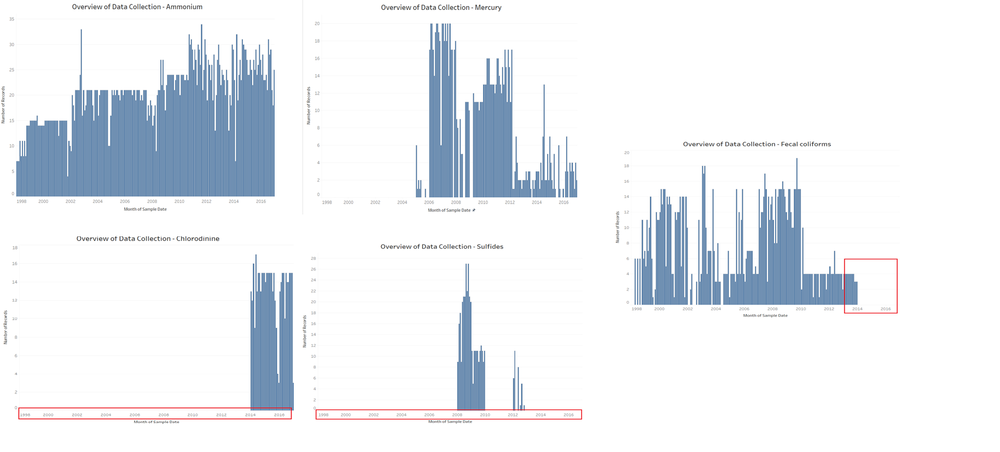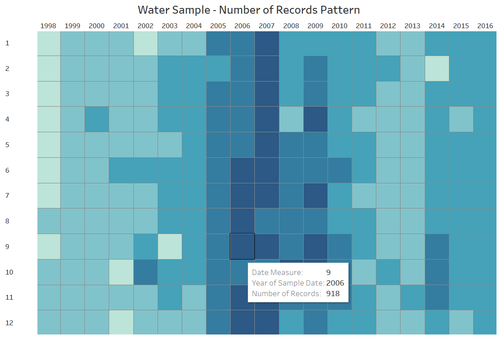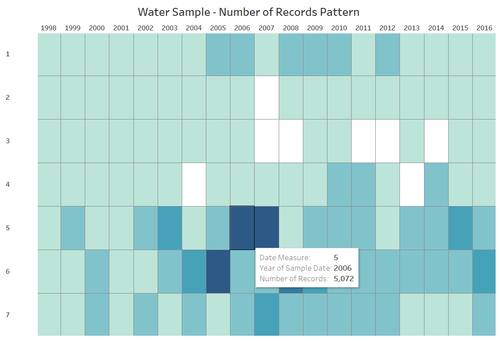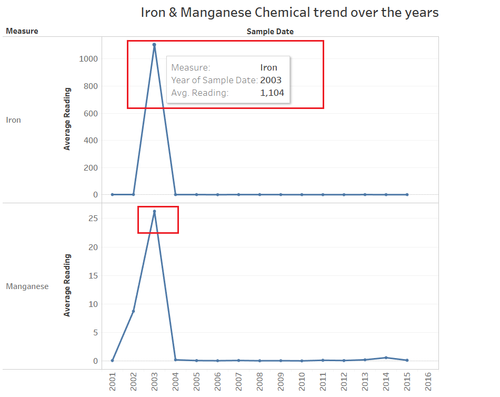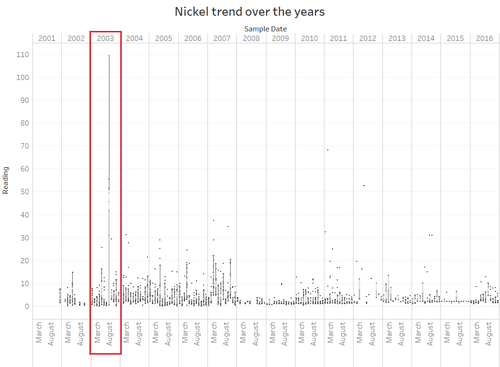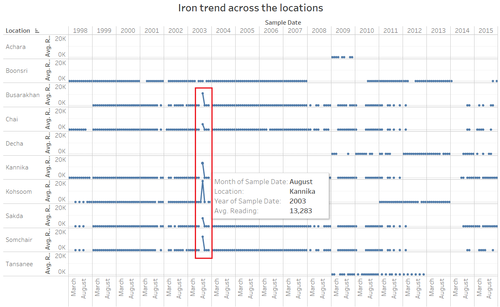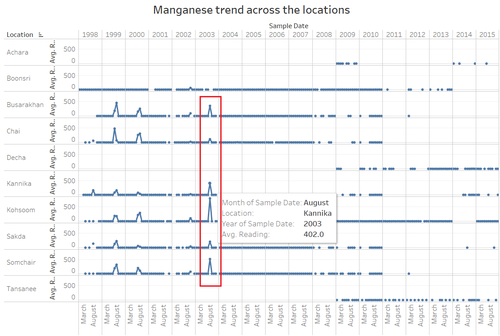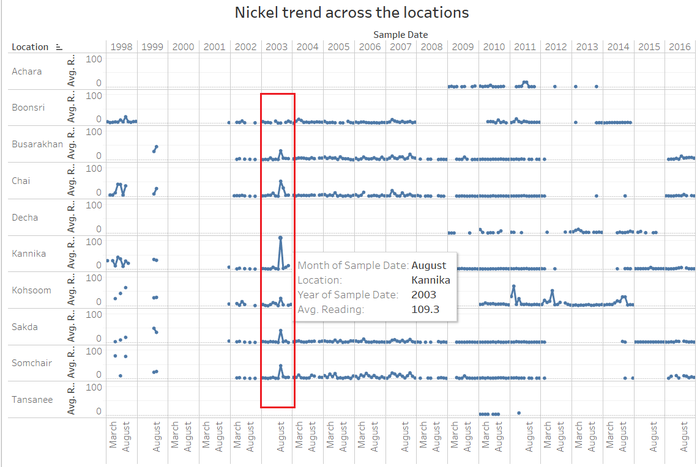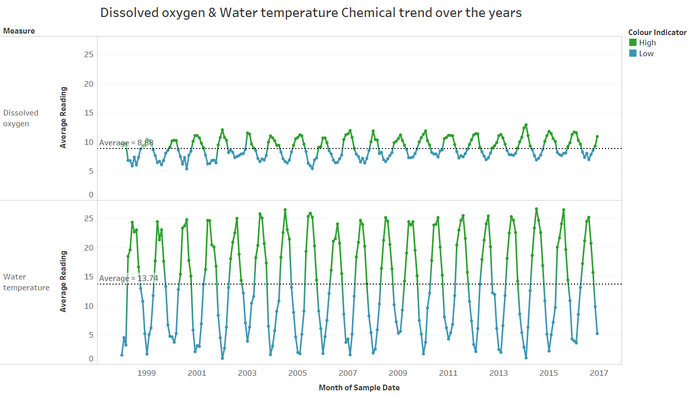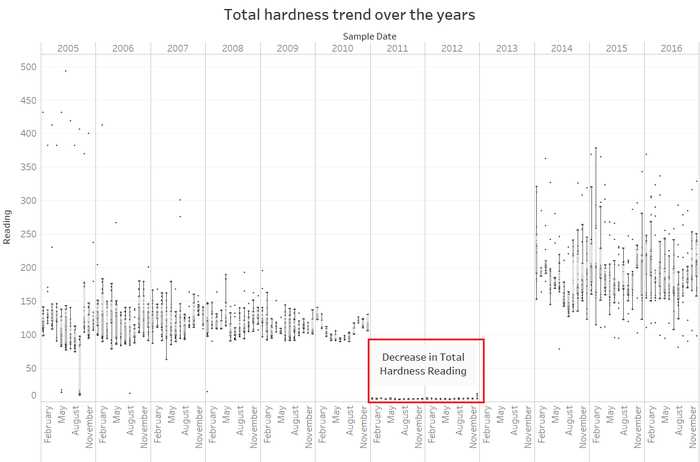Difference between revisions of "Insights"
Alagua.2017 (talk | contribs) |
|||
| (45 intermediate revisions by 2 users not shown) | |||
| Line 1: | Line 1: | ||
<div style=background:#2B3856 border:#A3BFB1> | <div style=background:#2B3856 border:#A3BFB1> | ||
| − | [[Image: | + | [[Image:Pic.jpg|400px]] |
| − | <font size = 6; | + | <font size = 6; color="#FFFFFF"> VAST Mini Challenge 2 - Like Duck To Water |
| + | </font> | ||
</div> | </div> | ||
<!--MAIN HEADER --> | <!--MAIN HEADER --> | ||
| Line 11: | Line 12: | ||
| style="font-family:Century Gothic; font-size:100%; solid #1B338F; background:#2B3856; text-align:center;" width="20%" | | | style="font-family:Century Gothic; font-size:100%; solid #1B338F; background:#2B3856; text-align:center;" width="20%" | | ||
; | ; | ||
| − | [[Data Preparation| <font color="#FFFFFF">''' | + | [[Data Preparation| <font color="#FFFFFF">'''DATA PREPARATION AND DASHBOARD DESIGN'''</font>]] |
| style="font-family:Century Gothic; font-size:100%; solid #1B338F; background:#2B3856; text-align:center;" width="20%"| | | style="font-family:Century Gothic; font-size:100%; solid #1B338F; background:#2B3856; text-align:center;" width="20%"| | ||
; | ; | ||
| − | |||
| − | |||
| − | |||
[[Insights| <font color="#FFFFFF">'''OBSERVATION AND INSIGHTS'''</font>]] | [[Insights| <font color="#FFFFFF">'''OBSERVATION AND INSIGHTS'''</font>]] | ||
| style="font-family:Century Gothic; font-size:100%; solid #1B338F; background:#0b3d53; text-align:center;" width="25%" | | | style="font-family:Century Gothic; font-size:100%; solid #1B338F; background:#0b3d53; text-align:center;" width="25%" | | ||
| + | ; | ||
| + | [[CONCLUSION| <font color="#FFFFFF">'''CONCLUSION'''</font>]] | ||
| + | | style="font-family:Century Gothic; font-size:100%; solid #1B338F; background:#2B3856; text-align:center;" width="20%" | | ||
| + | ; | ||
[[Assignment_Dropbox_G1| <font color="#FFFFFF">Back to Dropbox</font>]] | [[Assignment_Dropbox_G1| <font color="#FFFFFF">Back to Dropbox</font>]] | ||
| | | | ||
| Line 28: | Line 30: | ||
<br/> | <br/> | ||
| − | |||
<center> | <center> | ||
{| style="background-color:#ffffff ; margin: 3px 10px 3px 10px;" width="80%"| | {| style="background-color:#ffffff ; margin: 3px 10px 3px 10px;" width="80%"| | ||
| + | |||
| style="font-family:Open Sans, Arial, sans-serif; font-size:15px; text-align: center; border-top:solid #f5f5f5; background-color: #f5f5f5" width="150px" | | | style="font-family:Open Sans, Arial, sans-serif; font-size:15px; text-align: center; border-top:solid #f5f5f5; background-color: #f5f5f5" width="150px" | | ||
| − | [[ | + | [[ISSS608_2017-18_T3_Assign_Alagu_Alagappan_Q1|<font color="#3c3c3c"><strong>Question 1</strong></font>]] |
| − | | style="font-family:Open Sans, Arial, sans-serif; font-size:15px; text-align: center; border:solid | + | | style="font-family:Open Sans, Arial, sans-serif; font-size:15px; text-align: center; border-top:solid #f5f5f5; background-color: #f5f5f5" width="150px"| |
| − | [[ | + | [[ISSS608_2017-18_T3_Assign_Alagu_Alagappan_Q2|<font color="#3c3c3c"><strong>Question 2</strong></font>]] |
| + | |||
| + | | style="font-family:Open Sans, Arial, sans-serif; font-size:15px; text-align: center; border-top:solid #f5f5f5; background-color: #f5f5f5" width="150px" | | ||
| + | [[ISSS608_2017-18_T3_Assign_Alagu_Alagappan_Q3|<font color="#3c3c3c"><strong>Question 3</strong></font>]] | ||
| − | |||
| − | |||
|} | |} | ||
</center> | </center> | ||
| + | Link to tableau dashboard : [https://public.tableau.com/profile/alagu.alagappan#!/vizhome/VAST_MINI_CHALLENGE_2_Alagu/StoryBoard] | ||
| + | <font size = 3; color="#000000"><span style="font-family:Trebuchet MS; font-weight:bold;"><h2>GROUND REPORT AND CHEMICAL TRENDS</h2></span></font> | ||
| + | |||
| + | |||
| + | <b> 1.Data Collection Takes a Toll: </b> | ||
| + | The Waterway sample readings taken by the hydrology department shows a different pattern in the data collection in the past and recent years among the chemicals. The number of records every month taken by the sensors and monitors are different for each chemical. As shown below there are broadly five categories of data collection by the hydrology department:<br> | ||
| + | 1. <b> Complete Data:</b> These chemicals have data from the year 1998 – 2016 taken by the hydrology department. Even though the number of readings are different across the years, they have the complete pattern to detect the trends and anomalies. These are chemicals like Ammonium, Magnesium, Sodium, Sulphates, Zinc , water temperature.<br> | ||
| + | 2. <b>Data Available for Last few years:</b> These chemicals have data for the last few years from 2005-2016 taken by the hydrology department.These chemicals were not considered and recorded in the years before 2005. This pattern is exhibited for the chemicals like Mercury, Total nitrogen, total hardness.<br> | ||
| + | 3.<b>Data Missing for Recent years:</b> These chemicals have data missing for the recent years from 2014-2016.This might be due to the disappearance of chemical content in recent years or the sensors and monitors dint capture the data. This pattern is exhibited for the chemicals like Fecal coliforms, Atrazine, Endrin.<br> | ||
| + | 4.<b>Data Available only for Recent years:</b> These chemicals have data missing for the past years from 1998-2013.This suggests an possible interest in the investigation as the main toxic chemical namely Methylsomine falls in this category. Is there any reason behind not collecting the data for the past years? This pattern is exhibited for the chemicals like Chloridine, Methylsomine, Total organic carbon.<br> | ||
| + | 5.<b>Sparse Data:</b> These chemicals have data missing in between from the years 1998 - 2016.This causes the data to be sparse and also making it difficult to see the chemical contamination for these chemicals.This pattern is exhibited for the chemicals like Sulfides, Carbonates, Aluminium. | ||
| + | |||
| + | [[File:Alagu_Panel1.png|1000px|center]] | ||
| + | <b> 2.Captured Readings Shows Time Pattern</b> | ||
| + | |||
| + | To look deeper into the trend of the hydrology samples collected in the years of 1998-2016, the heatmap below shows the popular trends of chemicals recordings. It shows an distinctive feature for the most number of records collected is more in a particular period of the time considered:<br> | ||
| + | 1. Year : 2006 and 2007 has been the years with most data collected by the hydrology department for all the chemical readings as a whole. Before 2006, the number of records has been very less and recent number of records show increasing sample than past situation.<br> | ||
| + | 2. Months: Most number of Records taken by the hydrology deparatment are in the months of September, October, November and December compared to the number of records in other months. Quarter 4 has been the most sought-after quarter for recording the chemical measure.<br> | ||
| + | 3. Weekday: Friday and Saturday seem to show up more record samples for the chemicals across different locations. As the reason might not be certain for this pattern , this has been the trend repeated over the years. | ||
| + | [[File:Alagu_Trend_10.png|500px|left]] | ||
| + | [[File:Alagu_Trend_11.png|500px|right]]<br><br><br><br><br><br><br><br><br><br><br><br><br><br><br><br><br><br><br> | ||
| + | |||
| + | |||
| + | <b> 3. Metals Contaminate the preserve in August 2003: </b> | ||
| + | Iron has the sampling data recorded by the hydrology department over all the years from 1998 – 2015. So, looking at the trend of iron, it shows a unique increase in value in the year 2003 as the average reading goes up to 1104 mg/l. This is 1000 times higher than the average reading across all the years. According to WHO, the iron concentrations levels of 0.3 mg/litre are found acceptable in the rivers and streams. The concentration of chemical content in the year 2003 is 3000 times more than the permissible level. | ||
| + | Similarly, another chemical Manganese which has readings recorded in the years 1998-2015 the average reading peaks nearly 4 times in the year 2003. According to WHO, the iron concentrations levels of 0.4 mg/litre are found acceptable in the rivers and streams. The concentration of chemical content in the year 2003 is 70 times more than the permissible level.As the Nickel doesn’t have complete data from 1998 – 2015, the box plot is created to show the readings trend over the years as shown below. The median value of Nickel in the year 2003 show 41.7 mg/L. | ||
| + | [[File:Alagu_Trend_1.png|500px|left]] | ||
| + | [[File:Alagu_Trend_0.png|500px|right]]<br><br><br><br><br><br><br><br><br><br><br><br><br><br><br><br><br><br><br> | ||
| + | Looking deep into the cycle plot trend across locations for iron, nickel and manganese, the average value is high overall in all the locations (whichever location had hydrology data collected) except Boonsri in the Year 2003 specifically in the month of August. This suggests that there has been the iron, nickel and manganese chemical contamination across the preserve in the August 2003 period causing harm to the wildlife. These metal contaminations would make the rivers and stream unsuitable for both the aquatic and wildlife around the preserve. | ||
| + | [[File:Alagu_Trend_2.png|500px|left]] | ||
| + | [[File:Alagu_Trend_3.png|500px|right]] | ||
| + | [[File:Alagu_Trend_4.png|700px|center]] | ||
| + | <b> 4. Cyclic Trend </b> | ||
| + | |||
| + | The water temperature and dissolved oxygen has been showing up inverse relationship throughout the years in the readings measure as shown below. The average readings in a month show the trend that the months the water temperature is high , the dissolved oxygen has been low across the preserve. The colour indicator even shows the green colour where they are above the average readings. In the months of July and August, the water temperature is high and consequently the dissolved oxygen is low in the rivers and streams. | ||
| + | [[File:Alagu_Trend_5.png|700px|center]] | ||
| − | < | + | <b> 5. Total Hardness Showing Fluctuations </b> |
| + | The total Hardness has last few years data from 2005 to 2016. The median reading of total hardness has been around 117.7 µg/L in 2010 but all the readings in the preserve decreased to below 5 µg/L in the years 2011 and 2012. The median readings over the preserve has again increased in the years 2014 to 2016. The year 2013 doesn’t have any chemical reading value taken by the hydrology which has been shown in the graph below. So the total hardness has been showing an increasing trend in the preserve in the recent years 2014-2016 compared to the past situation. | ||
| + | [[File:Alagu_Trend_6.png|700px|center]] | ||
Latest revision as of 00:09, 9 July 2018
|
|
|
|
|
|
Link to tableau dashboard : [1]
GROUND REPORT AND CHEMICAL TRENDS
1.Data Collection Takes a Toll:
The Waterway sample readings taken by the hydrology department shows a different pattern in the data collection in the past and recent years among the chemicals. The number of records every month taken by the sensors and monitors are different for each chemical. As shown below there are broadly five categories of data collection by the hydrology department:
1. Complete Data: These chemicals have data from the year 1998 – 2016 taken by the hydrology department. Even though the number of readings are different across the years, they have the complete pattern to detect the trends and anomalies. These are chemicals like Ammonium, Magnesium, Sodium, Sulphates, Zinc , water temperature.
2. Data Available for Last few years: These chemicals have data for the last few years from 2005-2016 taken by the hydrology department.These chemicals were not considered and recorded in the years before 2005. This pattern is exhibited for the chemicals like Mercury, Total nitrogen, total hardness.
3.Data Missing for Recent years: These chemicals have data missing for the recent years from 2014-2016.This might be due to the disappearance of chemical content in recent years or the sensors and monitors dint capture the data. This pattern is exhibited for the chemicals like Fecal coliforms, Atrazine, Endrin.
4.Data Available only for Recent years: These chemicals have data missing for the past years from 1998-2013.This suggests an possible interest in the investigation as the main toxic chemical namely Methylsomine falls in this category. Is there any reason behind not collecting the data for the past years? This pattern is exhibited for the chemicals like Chloridine, Methylsomine, Total organic carbon.
5.Sparse Data: These chemicals have data missing in between from the years 1998 - 2016.This causes the data to be sparse and also making it difficult to see the chemical contamination for these chemicals.This pattern is exhibited for the chemicals like Sulfides, Carbonates, Aluminium.
2.Captured Readings Shows Time Pattern
To look deeper into the trend of the hydrology samples collected in the years of 1998-2016, the heatmap below shows the popular trends of chemicals recordings. It shows an distinctive feature for the most number of records collected is more in a particular period of the time considered:
1. Year : 2006 and 2007 has been the years with most data collected by the hydrology department for all the chemical readings as a whole. Before 2006, the number of records has been very less and recent number of records show increasing sample than past situation.
2. Months: Most number of Records taken by the hydrology deparatment are in the months of September, October, November and December compared to the number of records in other months. Quarter 4 has been the most sought-after quarter for recording the chemical measure.
3. Weekday: Friday and Saturday seem to show up more record samples for the chemicals across different locations. As the reason might not be certain for this pattern , this has been the trend repeated over the years.
3. Metals Contaminate the preserve in August 2003:
Iron has the sampling data recorded by the hydrology department over all the years from 1998 – 2015. So, looking at the trend of iron, it shows a unique increase in value in the year 2003 as the average reading goes up to 1104 mg/l. This is 1000 times higher than the average reading across all the years. According to WHO, the iron concentrations levels of 0.3 mg/litre are found acceptable in the rivers and streams. The concentration of chemical content in the year 2003 is 3000 times more than the permissible level.
Similarly, another chemical Manganese which has readings recorded in the years 1998-2015 the average reading peaks nearly 4 times in the year 2003. According to WHO, the iron concentrations levels of 0.4 mg/litre are found acceptable in the rivers and streams. The concentration of chemical content in the year 2003 is 70 times more than the permissible level.As the Nickel doesn’t have complete data from 1998 – 2015, the box plot is created to show the readings trend over the years as shown below. The median value of Nickel in the year 2003 show 41.7 mg/L.
Looking deep into the cycle plot trend across locations for iron, nickel and manganese, the average value is high overall in all the locations (whichever location had hydrology data collected) except Boonsri in the Year 2003 specifically in the month of August. This suggests that there has been the iron, nickel and manganese chemical contamination across the preserve in the August 2003 period causing harm to the wildlife. These metal contaminations would make the rivers and stream unsuitable for both the aquatic and wildlife around the preserve.
4. Cyclic Trend
The water temperature and dissolved oxygen has been showing up inverse relationship throughout the years in the readings measure as shown below. The average readings in a month show the trend that the months the water temperature is high , the dissolved oxygen has been low across the preserve. The colour indicator even shows the green colour where they are above the average readings. In the months of July and August, the water temperature is high and consequently the dissolved oxygen is low in the rivers and streams.
5. Total Hardness Showing Fluctuations The total Hardness has last few years data from 2005 to 2016. The median reading of total hardness has been around 117.7 µg/L in 2010 but all the readings in the preserve decreased to below 5 µg/L in the years 2011 and 2012. The median readings over the preserve has again increased in the years 2014 to 2016. The year 2013 doesn’t have any chemical reading value taken by the hydrology which has been shown in the graph below. So the total hardness has been showing an increasing trend in the preserve in the recent years 2014-2016 compared to the past situation.

